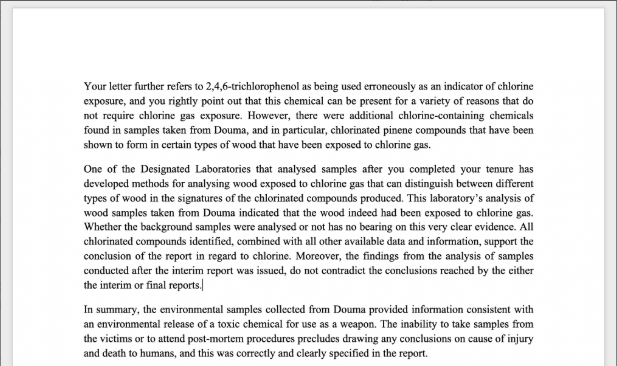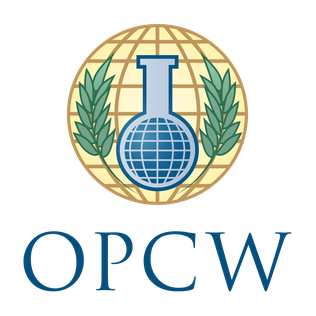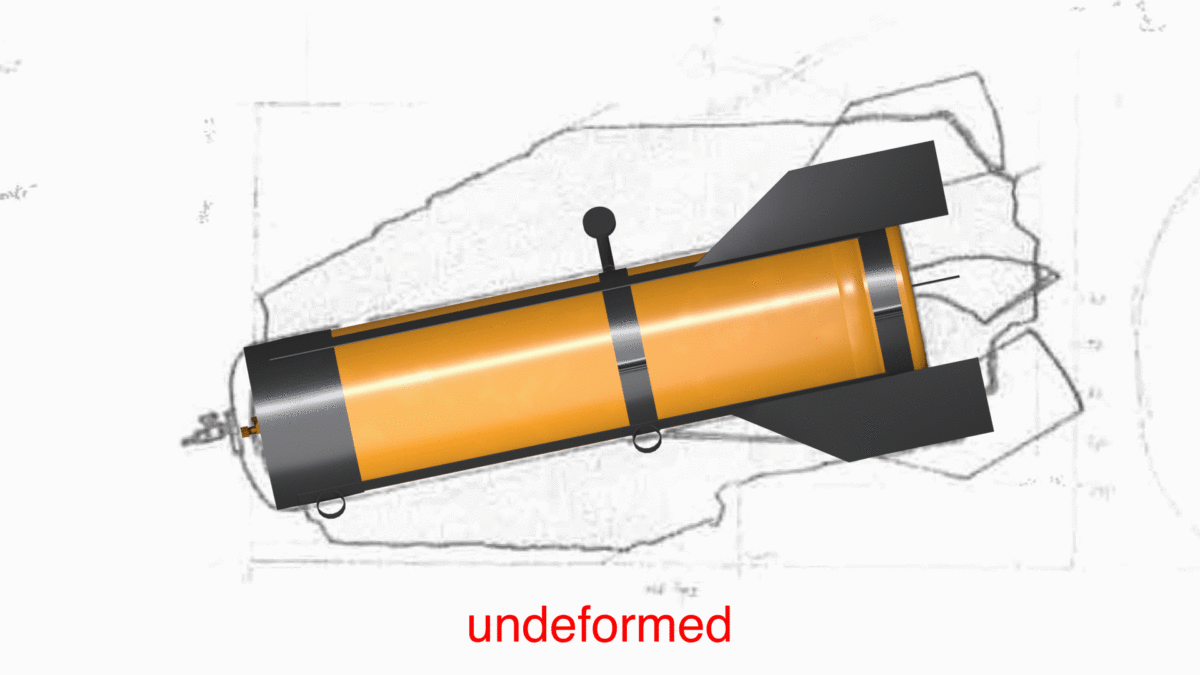The OPCW Douma Leaks Part 3: We Need To Talk About A “False Flag” Attack
In its final report, the Fact Finding Mission (FFM) of the Organisation for the Prohibition of Chemical Weapons (OPCW) stated that there are reasonable grounds to believe that on April 7, 2018, chlorine gas was used in an attack on the Syrian city of Douma. Despite that conclusion, claims the chemical attack in Douma were staged continue to circulate. These claims were further fueled by leaks from “Alex,” who claims to be an OPCW employee, and a leaked semi-independent engineering report authored outside the authority of the FFM. We have previously examined both Alex’s claims, and the engineering report in detail, and found significant problems with both.
As discussed in Part 2, as well as basing his report on a major assumption, Ian Henderson’s engineering report lacked a huge amount of extremely relevant context. As such, in the following article we will include that required context and examine what it would mean for the cylinders to have been placed at the scene manually. Needless to say, by saying that these cylinders were more likely placed manually, the implication is that what happened in Douma was some form of “false flag” attack.
It should be noted that the narrative the Russian and Syrian governments propose is simply that there was no chemical attack at all. This position was cemented during an Arria meeting of the UN Security Council. The Russian Federation and Syrian delegation claimed that this entire attack was staged and that there is no evidence of any chemical attack.
No major actor believes a “false flag” was carried out using chlorine. Indeed, if chlorine had been used, even as a “false flag”, the FFM final report would still stand, as their mandate is only to establish if a chemical weapon has been used or not. We are therefore entertaining the theory that no chlorine gas was present at this location.
The Context
It is first worth considering the overall context. During the evening of April 7, 2018, there was virtually non-stop shelling, incendiary attacks, and bombing in Douma.
To give an idea of how dire the situation was, the Douma pocket surrendered less than 24 hours after this chemical attack, bringing an end to fighting in this area. The bombardment was so intense that medical workers could not move through the city. Any potential plan that would have included placing these cylinders manually must have been carried out under this intense bombardment and chaos.

Extract of final FFM report
All the proposed activities we describe below must have taken place amidst this chaos of a small rebel pocket collapsing under attack from the Syrian government and its allies.
The Victims
In order to create the scene observed in open source materials, the bodies of at least 34 people, including men, women and children, would have had to have been obtained — possibly via mass murder. The victims would have had to be killed in a way that left no obvious visible trauma. All these bodies would have had to be fresh to account for livor and rigor mortis.
Either these people were killed in a way that produced a frothy discharge, or the froth was added later to bodies of people who were already dead. The Russian and Syrian presentation at the UN claimed that bodies were transported in from another location and that nobody in the building was affected by any gas. There are, of course, no images or videos showing any of these 34 bodies being unloaded from the cars they were allegedly transported in. No witnesses interviewed immediately after the attack by journalists or the OPCW reported bodies being transported into this location.

Slide from UNSC presentation
Some believe that all these people were killed by “dust inhalation”. This narrative first appears to have been written about by Robert Fisk who, although he visited Douma, did not actually bother to find or visit the building where the attack happened. Instead he found a single doctor to interview, who claimed that the fatalities that night were as a result of “hypoxia, oxygen loss” and implies this was a result of a dust storm in the area. It should be noted that there has not previously been a scenario during this conflict where scores of people died in the same building from dust inhalation. Indeed it was not possible to find any example of large numbers of people dying in the same building from dust inhalation in such a manner.
Unlike the final FFM report, the first draft of the interim report splits the witness accounts into those interviewed in Damascus and those interviewed in “Country X”. It is notable that the claims of mass casualties and fatalities from dust inhalation (amongst other causes) appear to originate from the group interviewed in Damascus. Indeed some of the medical workers interviewed in Damascus mentioned not even being aware of any chemical attacks in Douma or Syria. To put it frankly, the idea that any medical worker in Syria is not aware of chemical attacks is naive; chemical attacks have been a continuous and high profile feature of the conflict in Syria.
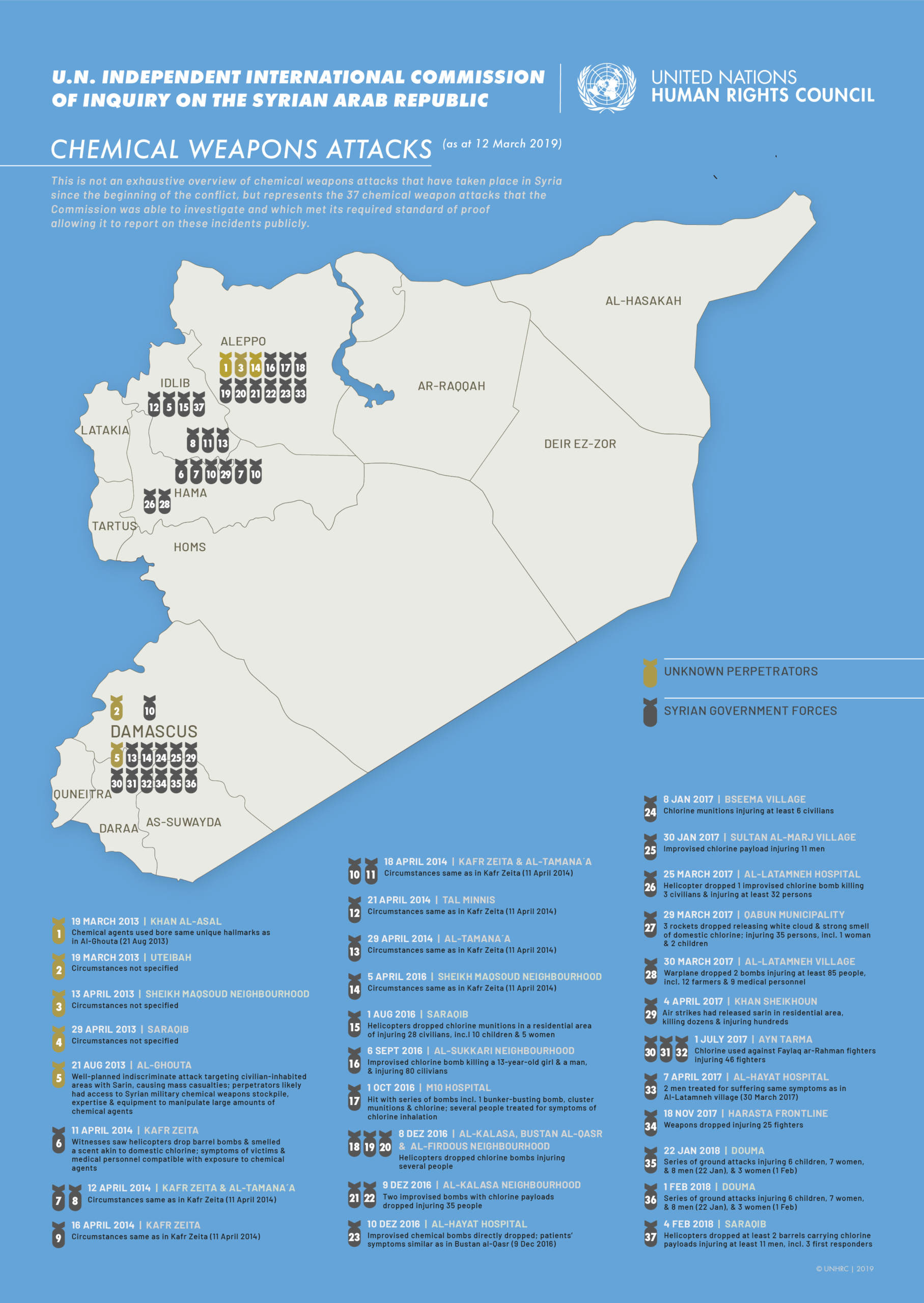
Chemical weapon attacks identified by the UN’s Independent International Commission of Inquiry on the Syrian Arab Republic
The witness statements to the OPCW made in Damascus do not seem to fit either what we know about the Douma attack, nor about the conflict in general. Considering the exceptionally repressive nature of the Syrian government, this is not surprising.
Rather bizarrely, Syrian medical workers interviewed by the Russian Ministry of Defence shortly after the attack said “all those who had received their medical aid had ordinary injuries, fractures and fragmentation and gunshot wounds.” None of these medical workers mention any injuries or deaths related to dust inhalation. This directly contradicts what Fisk reported, and helps to illustrate the confused narratives proposed by those who do not believe a chemical attack took place.
When you consider the chaos of that night, and the other requirements we’ve explored below, the idea that all these people were killed by a mechanism other than chlorine inhalation and the building was prepped to make it look like a chlorine attack in the course of just a few hours pushes the boundaries of absurdity.
Witnesses
Then there is the question of the witnesses. The perpetrators of any “false flag” attack would have had to make sure that the loved ones and family of those who were murdered or had their bodies used did not speak out. This would have been an incredibly difficult proposition considering immediately after this event there was no way to control the population of Douma, where people immediately became internally displaced or else refugees.
You would have to ensure witnesses who spoke to the FFM described details that suggest a chemical attack, such as victims with respiratory issues, and the smell of chlorine in the vicinity of the attacks. Some would need to recount seeing a greenish cloud in the vicinity of Location 2. The enforcement of this narrative would have had to have happened after Douma fell, in the chaos of a mass expulsion of people from government-held parts of Syria.
None of the witnesses, not even those interviewed in Damascus, appear to have mentioned anything about any group of people being detained and murdered. None mention any bodies being transported into Location 2. It seems extremely unlikely that this could have happened and not a single witness, in either Damascus or “Country X”, mentioned the capture and murder of scores of people, or the reuse of bodies. The only “witnesses” who claim to have seen the movement of bodies appeared in the Russian presentation to the UNSC almost two years later.
Journalists who, unlike Robert Fisk, did bother to visit the building where most victims died noted an irritating smell. They even met and interviewed at least one first-hand witness who explained how the attack took place.
“I was sitting in the basement when it happened; the house was hit around seven in the evening. We ran out, and women and children ran into the house. They didn’t know the house had been hit from above and was filled with gas. The one who ran into the house died immediately. I ran out, feeling dizzy”
Once again it should be noted that this witness did not mention anything about anyone having been murdered or any bodies being moved into this building. He only states that people ran into the building.
Finally, one would also have had to fabricate reports of two helicopters being in the air above Douma during the timeframe in which this chemical attack happened.
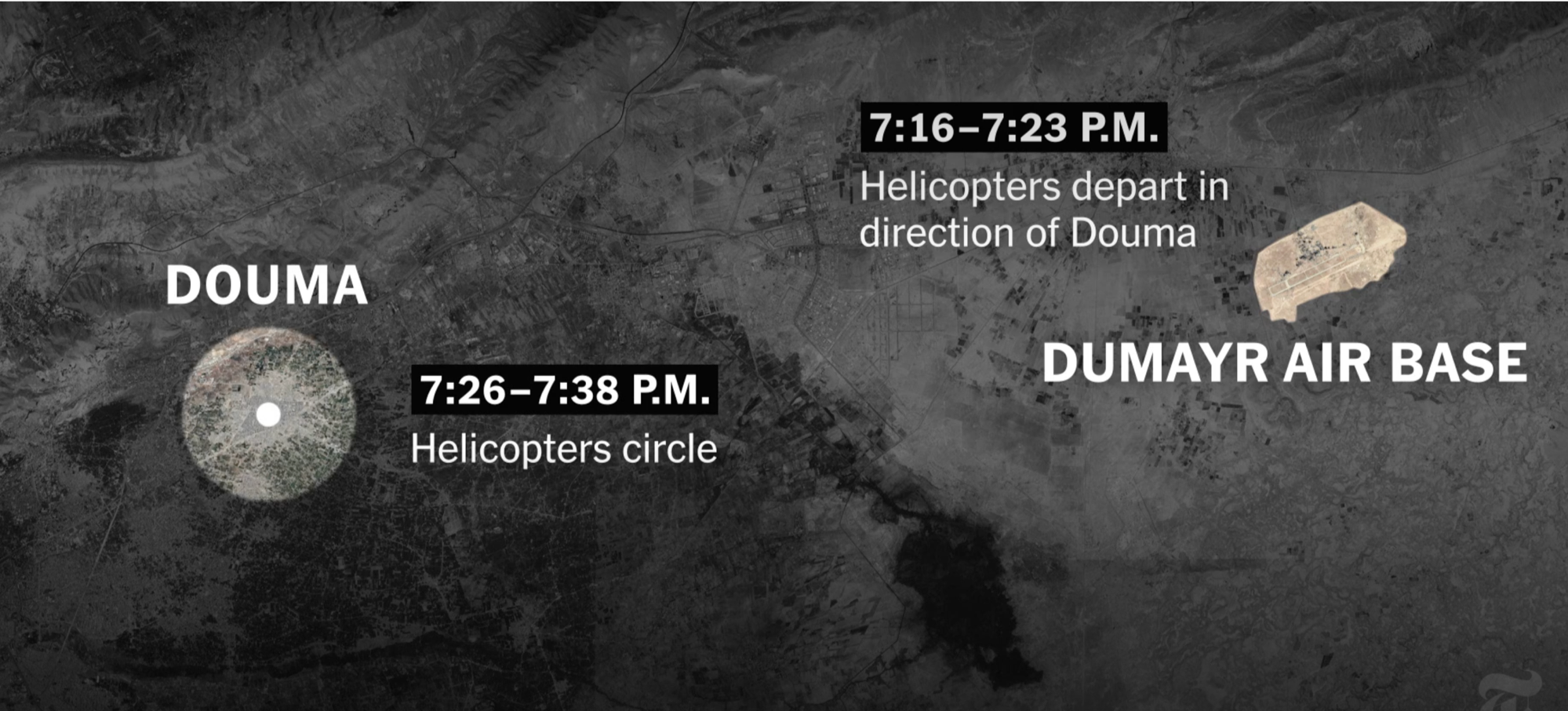
Graphic from the New York Times Visual Investigations Team investigation into Douma
The Munitions
Shortly before the victims were placed and first responders and media arrived, the cylinders would have to have been placed in position. Obtaining and modifying these cylinders to the required standard would have been a difficult task. To our knowledge, this kind of extremely distinctive chlorine cylinder with an external framework does not appear to have been used in the East Ghouta, of which Douma is part, prior to 2018.
The only reported attacks that these munitions may have been sourced from was a chemical attack on February 25, 2018, in which helicopters were reported to have been involved, and an attack in March 2018. Other reported chemical attacks in East Ghouta that Bellingcat is aware of used a different method of delivery, specifically an IRAM.

Comparison of an IRAM (left), primarily seen around Damascus, with a modified chlorine cylinder (right), which does not previously appear to have been reported in Damascus before 2018
If these cylinders and their framework were not obtained from an earlier attack, there are still two further options: they could have been smuggled in after other attacks in Syria, or they could have been manufactured from an unused chlorine cylinder, which is used to purify water in Syria. If they were manufactured, one must admire the skill and attention to detail of the artisan: the cylinders are, in virtually all respects, identical to munitions used in multiple previous attacks in other parts of the country. The only difference from earlier munitions appears to be the design of the suspension lugs. These modified chlorine cylinders have been used in scores of other chlorine attacks in other parts of Syria, as identified by multiple OPCW FFM, JIM, and other independent investigations.
If cylinders from a previous attack were used, they must have already been deformed in a manner that was consistent with them falling from height onto the buildings at Location 2 and 4. If these cylinders were not pre-deformed, they would then have had to be damaged in a manner which was consistent with them falling several hundred meters. This is not simply a matter of adding a few dents: these cylinders were heavily deformed in a manner that would have been extremely difficult to achieve, if not impossible, using normal tools.
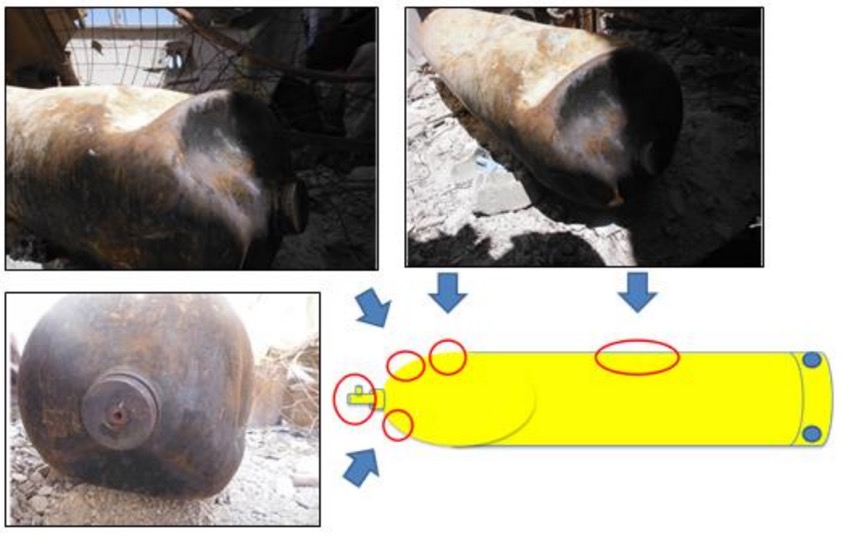
Damage to cylinder at Location 2 seen in final FFM report
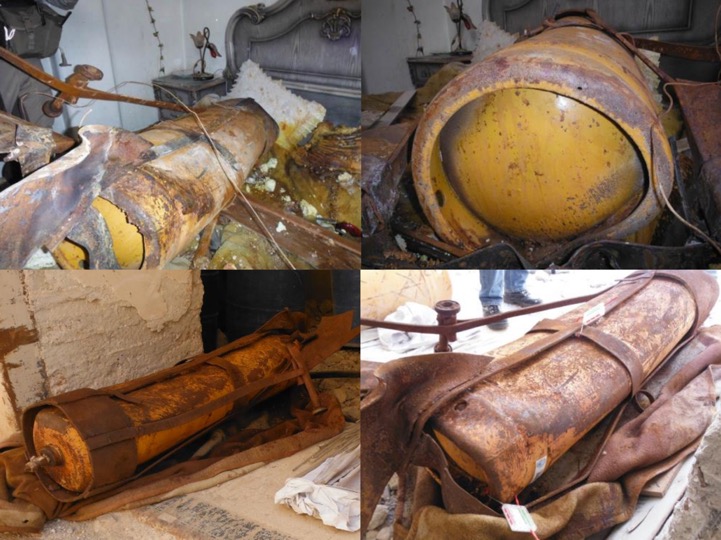
Damage to cylinder at Location 4 seen in final FFM report
The idea of constructing a platform several hundred meters high in Douma and then dropping the cylinders off it is comedic — and defies any logic. This damage would have had to be consistent with impacts at both Location 2 and Location 4 in order to fool three independent teams of engineering experts commissioned for the final FFM report. The frame of the munition at Location 2 would have had to be stripped, deformed, and then mixed with the other debris.
One of the biggest problems with reusing a chlorine cylinder from a previous attack is that it would almost certainly already be heavily corroded after having come into contact with chlorine.
When chlorine gas meets moisture it reacts to form hydrochloric and hypochlorous acids, both of which are corrosive to metal. Corrosion on metal parts at Location 2 and 4 was noted by the FFM. This is most clear when examining the cylinder at Location 4. Immediately after the attack the cylinder and frame were clearly not corroded; however, by the time the inspectors tagged the cylinder on June 3, 2018, it was heavily corroded. This makes it extremely unlikely that this cylinders were reused from previous attacks: these cylinders would have displayed significant corrosion in earlier images. They do not.

1: Still from video by Forensic Architecture, 2: Still from video by Forensic Architecture, 3: Image taken on 8th or 9th April, 4: image from Russian news report aired on 26th April, 5: image of cylinder in FFM final report, 6: image of cylinder in Final FFM report after tagging, indicating it was taken on the 3rd June 2018
Placing these cylinders would have been a more difficult task than it first appears. Similar cylinders weigh around 60-80 kg when empty, depending on capacity. This would have been difficult enough to transport up the stairs at Location 2. However, at Location 4 the mangled framework was present on the cylinder, making it an extremely bulky object to get up the stairs and through the door, apparently without leaving any obvious marks. Even the first hand witness who claims to have been in the building and who blames the rebels, states that these locations were “hit’ and nothing about anyone placing any cylinder.
In short, there is no believable way these cylinders could have been obtained or manufactured so that they looked consistent with not only the damage, but also the progression of corrosion visible at the scene.
The Craters
Two craters would have had to be created for the “false flag” scenario. The FFM identified that the craters present on the scene were consistent with the impact of the cylinders. The FFM also noted that the crater at Location 2 does not appear to have been created by an explosion due to the absence of primary and secondary fragmentation. Even Henderson noted that this lack of fragmentation was strange, although he still believed it may have been created by an explosion. Once again, the artisans who supposedly created these craters must have been incredibly skilled, as they were good enough to fool three independent analyses of the impacts.
Whoever placed these cylinders would also have needed almost superhuman foresight to damage the edge of the terrace wall. The damage to both the cylinder and the wall would, yet again, have had to be consistent with the cylinder having impacted the edge of the terrace wall first, followed by impacting the floor. Indeed, the damage would, once again, need to fool three independent analyses of the impact of this cylinder. Syrian media activists, who presumably must have been collaborating with the perpetrators, completely missed this vital detail in all their images and videos. This was first noticed due to Russian news reports from the site.
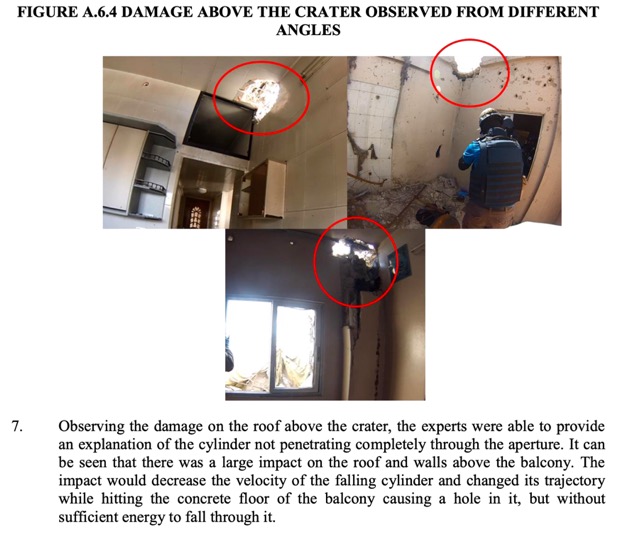
Extract from final FFM report
The Chemistry
In the case of a “false flag” attack, samples, as well as the corrosion of the cylinders, and other metal fittings in the room, would also have had to be fabricated. Consistent and believable samples would have been extremely difficult to simulate.
The compounds found by the FFM at Locations 2 and 4 that are indicative of chlorine cannot simply be dismissed as “trace” quantities, as we have already discussed. Trace quantities are exactly what would be expected in this situation — rather, it is the combination of different chemicals discovered that indicate the presence of chlorine gas. There is also the matter of other chemicals, such as inorganic chlorides (not mentioned by Alex), which were found far above trace levels.
There is also the bornyl chloride and trichlorophenol found in coniferous wood samples, which are not naturally found in the environment. Bornyl chloride can be produced from the interaction of phosgene or cyanogen chloride (both also deadly gases) with coniferous wood. Trichlorophenol can be produced by the interaction of sodium hypochlorite with coniferous wood, the main component of chlorine-based bleach. However, chlorine gas interacts with wood to create both.
Without knowing where the OPCW was going to check, the perpetrators would have had to go to extraordinary lengths to fake these samples. Whatever process they carried out would not only have had to produce results that are perfectly consistent with exposure to chlorine gas, but also affect samples from across the two locations, both inside and out. Essentially, it would have been extraordinarily difficult to believably fake a scene resulting in the samples identified by the OPCW.
By far the most likely scenario to produce bornyl chloride, trichlorophenol and the multitude of other compounds was that chlorine gas was present in the environment. It should be noted this is a simplification of the full process and that a full discussion of bornyl chloride and trichlorophenol can be read on page 13 of the final FFM report. These findings are antithetical to the Russian and Syrian claim that there was no chemical attack at all. Even if there had been a “false flag” attack using chlorine gas, the FFM findings would still stand, as chlorine would still have been used as a chemical weapon.
Auto-Refrigeration
Whoever staged such a “false flag” would also have had to have known and solved the problem of auto-refrigeration. In short, when canisters of chlorine discharge, they get very cold: cold enough to freeze water. This results in the container accumulating a of frost on the external part of the cylinder.
Example of auto-refrigeration on a chlorine munition, courtesy of Al Jazeera
The cylinder at Location 2 appears in a single (extremely graphic) video on the night of April 7, and the bright white appearance of the cylinder indicates it has undergone this process and that it is covered in frost.
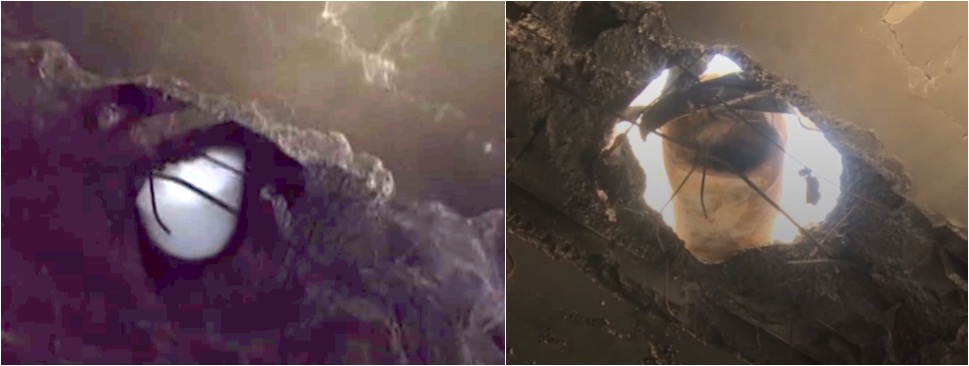
Stills of cylinder immediately after attack (Left) and at a later date (Right). The image on the left has been brightened to show details more clearly.
This could be done by either actually discharging a tank of chlorine, in which case there was a chlorine attack, or by somehow making the tank appear as if it had undergone this process, although how this could be achieved is not clear, especially as the effect would need to disappear within a few hours. The perpetrators would have had to go through the effort of faking this process, only for it to be caught by a few frames of a single video.
Conclusion
Currently, the Russian and Syrian governments and Alex all believe that chlorine was not used as a weapon, despite the large amount of evidence indicating chlorine was in fact present at these locations.
A “false flag” attack would have been extremely complex to plan and execute, relying either on the murder of multiple people (which not a single witness mentioned), or the discovery of an unprecedented number of people who had died from “dust inhalation”. These bodies would then have had to be transported to the building and unloaded. Unloading these bodies would have had to have happened without anyone taking any pictures or video. Indeed none of the apparent witnesses to this act presented by Russia at the UNSC on January 20, 2020, appear to have been interviewed by any journalist from any news organisation, or indeed any international organisation such as the OPCW, after the attack. This plan would have had to be executed during a period of incredibly heavy shelling, as the frontlines of this tiny rebel-held pocket collapsed.
The fakery, from the manufacturing of the cylinders to the chemical samples, would have had to be carried out to an incredibly high standard, indeed high enough that it could fool not only the FFM, but also multiple witnesses at the site of the attack. The craters and cylinder would have had to be perfectly consistent with two cylinders falling from height and impacting the roofs in order to fool the three independent analyses carried out by the FFM.
Or, on the evening of April 7, 2018, in an attack that is entirely consistent with scores of other attacks that have been recorded in Syria, one or more helicopters dropped two chlorine cylinders. These cylinders were modified to make them more effective air-dropped weapons, in a way that closely matched multiple other chlorine attacks. One landed on a building and crashed through the roof. The other hit a roof but did not fully penetrate it, discharging its contents of chlorine into the house beneath, killing dozens of men, women and children.
